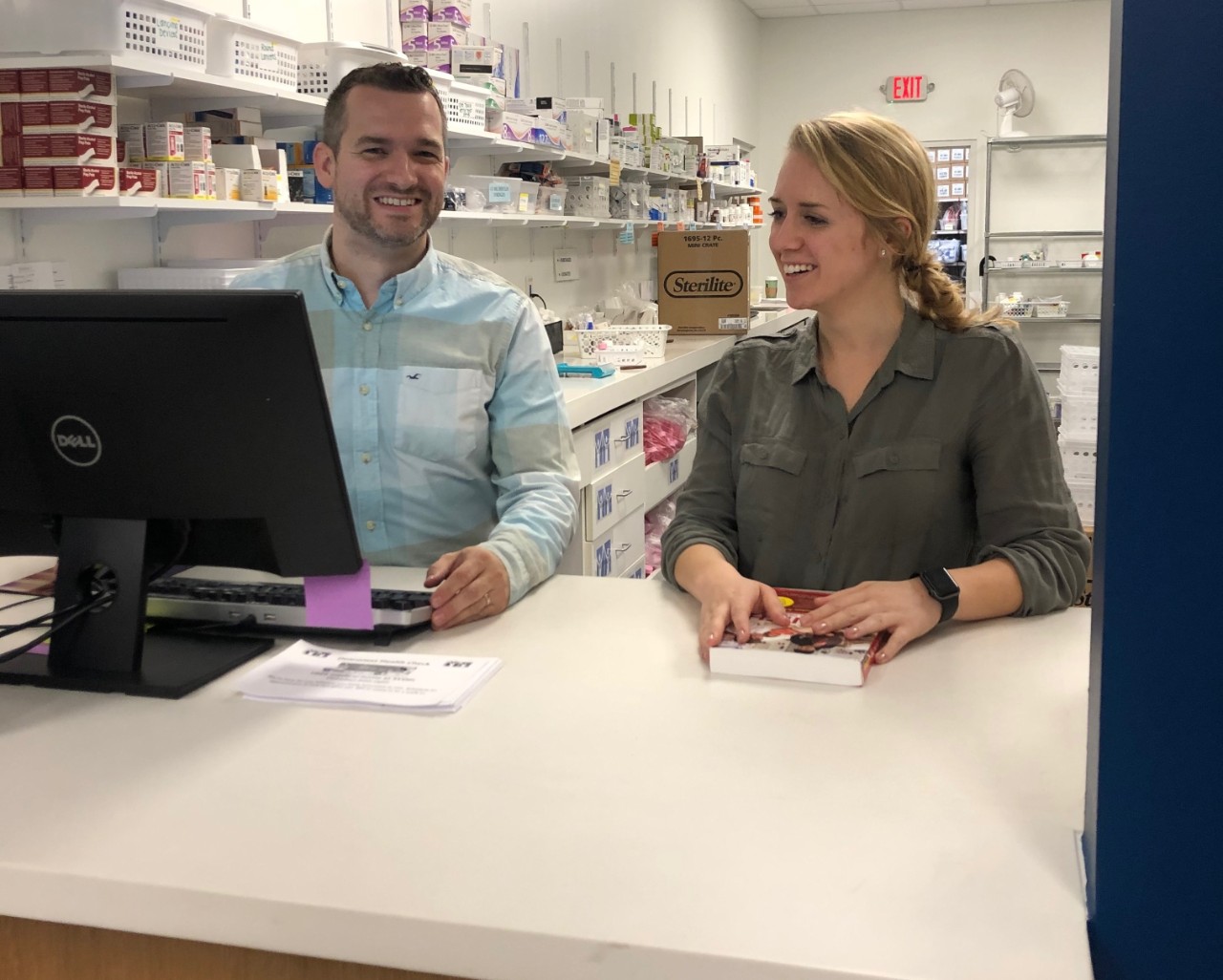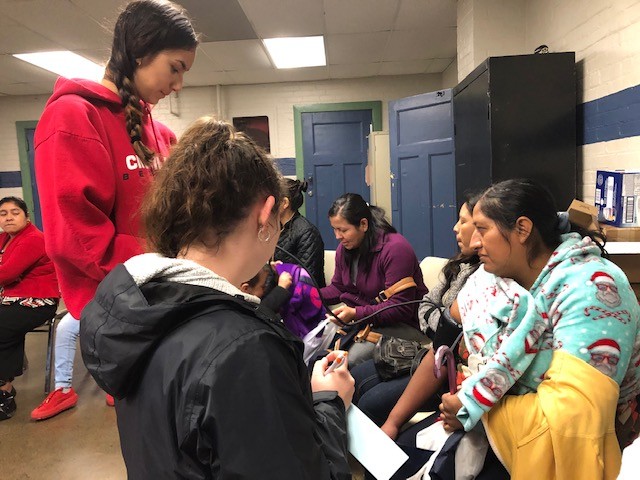
UC helps to overcome something vast and dangerous – the language barrier
A&S students aid Cincinnati’s Hispanic immigrants through experiential learning program

Second-year nursing major Samantha Luna gives health screening to mothers during Su Casa Hispanic Center’s Health Day.
By Tawney Beans
University of Cincinnati senior Brooke Brigadoi stands behind the pharmacy counter at St. Vincent De Paul.
Her first customer, a middle-aged Hispanic man clad in construction gear, approaches her window.
Only a few inches of countertop separates him from the pharmacists, but the language gap feels miles long. It's a fissure Brigadoi is here to fix. She has challenged herself to complete 100 hours of service learning here, but at this moment her only objective is to confirm this man’s identity and get him the medicine he needs.
The UC College of Arts and Sciences launched a new service-learning certificate in the Department of Romance and Arabic Languages and Literatures.
Nearly 40 students such as Brigadoi are scattered throughout Cincinnati in any given semester.
Spanish professor Ligia Gómez is the director of the program. Its title, the Certificate of Spanish for Service Learning in Social Work and Health Care Services, echoes the program’s goal to give Cincinnati’s Hispanic community access to vital programs by overcoming the language barrier.
“There are many nonprofit organizations that have a Hispanic population, but they don’t have enough bilingual providers,” Gómez said. “When students go into the community, they practice their Spanish by helping low income immigrants have access to social work and health services.”
The need
Gómez previously worked for a pediatrician, where she saw firsthand the Hispanic community’s need for interpretive services. She also chairs The Greater Cincinnati Latino Coalition, which works with local providers to help low-income immigrants in Cincinnati access culturally competent services. Gómez came to UC to instill her passion for the Hispanic community within the next generation and build a workforce that knows both the community’s language and culture.
Unbeknownst to many Cincinnatians, those in the Hispanic community have limited access to local mental health, transportation and social services, she said.
And while many low-income Americans struggle navigating the healthcare system, this process is considerably more complex for Hispanic immigrants, according to Gómez.
“Really all of this is aggravated by the language barrier, so if you have the language barrier it is going to affect everything else,” Gómez said. “Another thing is the need for bilingual social workers, pharmacists and nurses.”
The program
Over the last decade, Gómez has fostered partnerships with 14 local social service providers, including Women Infants and Children (WIC), the pharmacy at St. Vincent De Paul and Santa Maria Community Services. After evaluating a student’s Spanish proficiency, interests and post-graduation goals, she assigns them to a service provider.
The students are in high demand, Gómez said. This semester the program is also working with a school-based health center, allowing students to work with health professionals one-on-one and interact with young patients.
The impact
The program helps further UC’s Urban Impact initiative, an innovative strategy designed to improve the human condition and advance the Cincinnati community through collaborations. Whether it’s educating mothers about breastfeeding or helping diabetic patients with their insulin, Gómez’s students are making that impact on Cincinnati’s Hispanic population.
At St Vincent De Paul’s Pharmacy, Brigadoi was responsible for collecting patient medical information and ensuring that they knew where to call and what medicines they were taking. She felt like her contribution had an immediate impact, Brigadoi said.
“Many of the families wanted to receive medication so that they could breathe better to take care of their children and home,” Brigadoi said. “I liked being able to do that: close the gaps of communication so that they could understand what was happening so that they felt confident in their health and taking care of themselves.”
The program gives students the opportunity put their classroom knowledge to the test — a vital part of UC’s commitment to experiential learning. A fundamental part of her classes’ experience-based learning is reflection, Gómez adds. She wants her students to think about how the new community relates to them and what they believe their role is there.
Students also complete a final project for each service-learning course in the program that must be "with the community, for the community." These projects range from videos about Sudden Infant Death Syndrome to classes about nutrition to Spanish cheat sheets for medical professionals to use when no interpreters are available.
“It’s a good way for the students to have an impact and real experience using their Spanish and skills from nursing, social work or pre-med,” Gómez said.
She also encourages students to study abroad so they can do service learning in Spanish-speaking countries and see where their patients come from.
“I think it’s an incredible opportunity to open their eyes to other cultures, social economic statuses and other realities that we are not familiar with,” Gómez said. “That is making them into better human beings.”
According to Luz Elena Schemmel, Santa Maria’s Director of Immigrant and Wellness Services, UC students have played a pivotal part in their ability to offer certain services to the Hispanic community.
“We have students who have been helping us for more than a year,” Schemmel said. “One of [Gómez’s] students received a volunteer award for her contribution. Other students have applied for Americorps positions and were later hired by us.”
This was the case for Hunter Lang, Santa Maria’s Project Advance AmeriCorps Director, who took three of Gómez’s classes during his last year as an undergraduate student. These made him more prepared to interact with Spanish-speaking patients during the nonprofit’s client hours.
“The Spanish Medical Service-Learning program exposes students to issues of access to medical care, as well as to the barriers that Spanish-speaking individuals experience in our healthcare system,” Lang said. “The classes also train students to be prepared to enter medical and social service fields where they can have a larger impact on a community after graduation. It led directly to my professional development and the career track that I’m on now. It all started in Ligia’s program.”
Featured image at top: Katherine Pastor, a fourth-year nursing major, converses with St. Vincent De Paul’s Pharmacist.
Related Stories
Monica Turner elected chair of UC's Board of Trustees
January 13, 2025
P&G executive Monica Turner was elected Chair of the University of Cincinnati Board of Trustees. Gregory Hartmann was elected Vice Chair, and Jill McGruder was elected as Secretary.
Why is Facebook abandoning fact-checking?
January 10, 2025
UC Professor Jeffrey Blevins talks to France TV Washington about Facebook's decision to stop fact-checking public posts and allowing community notes instead to address disinformation.
UC’s Taft Research Center offers new public humanities seminars
January 10, 2025
This spring, the Charles Phelps Taft Research Center will offer two hands-on, credit-bearing research courses designed for students to read, think and work collaboratively across the humanities and social sciences.
